Abstract
Freeze-fracture studies have revealed a surface layer of rodlets on spores ofSyncephalastrum racemosum. Rodlets can be removed by treatment with alkali. Analysis of the extracts indicated the presence of a glycoprotein with a molecular weight of approximately 12,000.
Similar content being viewed by others
Literature Cited
Aronson, A. I., Fitz-James, P. C. 1975. Properties ofBacillus cereus spore coat mutants. Journal of Bacteriology123:354–365.
Beever, R. E., Dempsey, G. P. 1978. Function of rodlets on the surface of fungal spores. Nature272:608–610.
Bull, A. T. 1970. Chemical composition of wild-type and mutantAspergillus nidulans cell walls. The nature of polysaccharide and melanin constituents. Journal of General Microbiology63:75–94.
Bullivant, S., Ames, A. 1966. A simple freeze-fracture replication method for electron microscopy. Journal of Cellular Biology29:435–447.
Dubois, M., Gilles, K., Hamilton, J. K., Rebers, P. A., Smith, F. 1951. A colorimetric method for the determination of sugars. Nature168:167.
Hashimoto, T., Wu-Yuan, C. D., Blumenthal, H. J. 1976. Isolation and characterization of the rodlet layer ofTrichophyton mentagrophytes microconidial wall. Journal of Bacteriology127:1543–1549.
Hess, W. M., Sassen, M. M. A., Remsen, C. C. 1968. Surface characteristics ofPenicillum conidia. Mycologia60:290–303.
Hess, W. M., Stocks, D. L. 1969. Surface characteristics ofAspergillus conidia. Mycologia61:560–571.
Hobot, J. A., Gull, K. 1977. The influence of glucose availability on events during germination ofSyncephalastrum racemosum sporangiospores. Journal of General Microbiology98:431–437.
Lowry, O. H., Rosebrough, N. J., Farr, A. L., Randall, R. J. 1951. Protein measurement with the Folin phenol reagent. Journal of Biological Chemistry193:265–275.
Rosenberger, R. F. 1975. The cell wall, pp. 328–344. In: Smith, J. E., Berry, D. R. (eds.), The filamentous fungi, vol. II. London: Edward Arnold Ltd.
Smith, J. E., Gull, K., Anderson, J. G., Denas, S. G. 1976. Organelle changes during fungal spore germination, pp. 301–352. In: Weber, D. J., Hess, W. M. (eds.), The fungal spore—form and function. New York: John Wiley & Sons.
Somerville, H. J., Delafield, F. P., Rittenberg, S. C., 1968. Biochemical homology between crystal and spore protein ofBacillus thuringiensis. Journal of Bacteriology96:721–726.
Somerville, H. J., Delafield, F. P., Rittenberg, S. C. 1970. Ureamercaptoethanol-soluble protein from spores ofBaccillus thuringiensis and other species. Journal of Bacteriology101:551–560.
Swank, R. T., Munkres, K. D. 1971. Molecular weight analysis of oligopeptides by electrophoresis in polyacrylamide gel with sodium dodecyl sulfate. Analytical Biochemistry39:462–477.
Author information
Authors and Affiliations
Rights and permissions
About this article
Cite this article
Hobot, J.A., Gull, K. Structure and biochemistry of the spore surface ofSyncephalastrum racemosum . Current Microbiology 5, 183–185 (1981). https://doi.org/10.1007/BF01578526
Issue Date:
DOI: https://doi.org/10.1007/BF01578526




